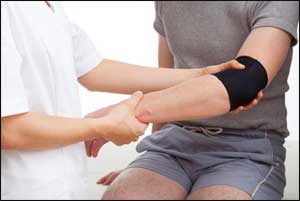- Home
- Editorial
- News
- Practice Guidelines
- Anesthesiology Guidelines
- Cancer Guidelines
- Cardiac Sciences Guidelines
- Critical Care Guidelines
- Dentistry Guidelines
- Dermatology Guidelines
- Diabetes and Endo Guidelines
- Diagnostics Guidelines
- ENT Guidelines
- Featured Practice Guidelines
- Gastroenterology Guidelines
- Geriatrics Guidelines
- Medicine Guidelines
- Nephrology Guidelines
- Neurosciences Guidelines
- Obs and Gynae Guidelines
- Ophthalmology Guidelines
- Orthopaedics Guidelines
- Paediatrics Guidelines
- Psychiatry Guidelines
- Pulmonology Guidelines
- Radiology Guidelines
- Surgery Guidelines
- Urology Guidelines
Walking ability after stroke improves with arm exercise

Researchers from the University of Victoria in British Columbia, Canada have conducted a new study to test the influence of arm training on post-stroke leg function and found that arm exercises may improve walking ability after a stroke. These results could have a large impact on stroke rehabilitation, even years after injury. The study published as an AP Select article ahead of print in the Journal of Neurophysiology.
Researchers worked with a group of older adults who had had a stroke between 7 months and 17 years prior to the study. The volunteers participated in three 30-minute, moderate-intensity arm cycling training sessions each week for five weeks. The research team measured the volunteers' physical abilities before and after arm training using several standardized scales and tests of physical function, including:
- Six Minute Walk, which measures how far a person can walk in six minutes;
- Timed 10 Meter Walk, which measures how quickly a person can walk 10 meters; and the
- Timed Up and Go, which measures the time it takes to stand up from a seated position, walk 10 feet, turn around, walk back and sit down again.
The researchers also tested electrical activity in the muscles and stretch reflexes in the lower legs and wrists during both arm cycling and walking tests.
The participants improved their performance significantly on all of the walking tests -- as much as 28 percent in the Timed Up and Go test. Several volunteers had less tightness in their muscles after completing the arm cycling trial, but there was no significant change in grip strength. Nerve activity increased during arm cycling as well. "Arm cycling training activated interlimb networks that contribute to the coordination of rhythmic walking," the researchers wrote. In other words, nerves in the arms activated and adapted to improve function of the spinal cord in other areas of the body, such as the legs, affected by stroke.
"Although improvements in walking may not be as robust as those from other training modalities, they do highlight the integral role that training the arms can have on rehabilitation of human locomotion," the research team wrote.
ExerciseexercisesinjuryJournal of NeurophysiologyNeurophysiologystrokestroke rehabilitationUniversity of Victoria in British ColumbiawalkingWalking ability
Source : Press ReleaseNext Story
NO DATA FOUND

Disclaimer: This site is primarily intended for healthcare professionals. Any content/information on this website does not replace the advice of medical and/or health professionals and should not be construed as medical/diagnostic advice/endorsement or prescription. Use of this site is subject to our terms of use, privacy policy, advertisement policy. © 2020 Minerva Medical Treatment Pvt Ltd